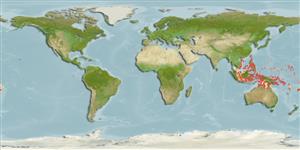Teleostei (teleosts) >
Gobiiformes (Gobies) >
Gobiidae (Gobies) > Gobiinae
Etymology: Trimma: Greek, trimma, -atos = something crushed (Ref. 45335); cana: Specific epithet is an arbitrary combination of letters embodying the first three letters of both the English words 'candy' and 'cane'; an allusion to adding red bands to a white candy formed in the shape of a shepherd's crook. An noun in apposition..
More on author: Winterbottom.
Environment: milieu / climate zone / depth range / distribution range
Ecology
Marine; demersal; depth range 12 - 35 m (Ref. 90102). Tropical
Western Pacific: Philippines, Caroline Is., Fiji, Marshall Is., and Palau
Size / Weight / Age
Maturity: Lm ? range ? - ? cm
Max length : 2.5 cm SL male/unsexed; (Ref. 52975)
Dorsal spines (total): 7; Dorsal soft rays (total): 9 - 10; Anal spines: 1; Anal soft rays: 8 - 10. Diagnosis: White background with 8 distinct vertical bars on head and body; yellow spots on the medial fins; a well-defined dark bar across the postorbital region of the skull (may be partially obscured by the overlying anterior extension of the epaxialis body musculature in larger specimens). No scales on head. Opercle, cheek, or nape. A second dorsal spine varying from slightly to very elongate (as far as the mid-peduncle). A well-developed interorbital trench. A variably-developed postorbital trench (usually developed). A fifth pelvic fin ray which is unbranched and 50-85% of the fourth.
Solitary or in small groups on surface of hard corals. Inhabits steep outer reef slopes in 12-35 m (Ref. 90102).
Life cycle and mating behavior
Maturities | Reproduction | Spawnings | Egg(s) | Fecundities | Larvae
Winterbottom, R., 2004. Three new species of Trimma (Pisces: Gobiidae) from the central, western and south Pacific. aqua, J. Ichthyol. Aquat. Biol. 9(1):7-16. (Ref. 52975)
IUCN Red List Status (Ref. 130435)
Threat to humans
Harmless
Human uses
Tools
Special reports
Download XML
Internet sources
Estimates based on models
Preferred temperature (Ref.
123201): 26.3 - 29, mean 28 °C (based on 102 cells).
Phylogenetic diversity index (Ref.
82804): PD
50 = 0.5000 [Uniqueness, from 0.5 = low to 2.0 = high].
Bayesian length-weight: a=0.01023 (0.00477 - 0.02194), b=3.02 (2.84 - 3.20), in cm total length, based on LWR estimates for this (Sub)family-body shape (Ref.
93245).
Resilience (Ref.
120179): High, minimum population doubling time less than 15 months (Preliminary K or Fecundity.).
Fishing Vulnerability (Ref.
59153): Low vulnerability (10 of 100).
Nutrients (Ref.
124155): Calcium = 1050 [421, 3,702] mg/100g; Iron = 3.08 [1.49, 7.03] mg/100g; Protein = 17.4 [15.3, 19.1] %; Omega3 = 0.285 [0.093, 0.794] g/100g; Selenium = 47.7 [15.7, 125.5] μg/100g; VitaminA = 32.2 [7.5, 129.8] μg/100g; Zinc = 4.04 [2.34, 6.73] mg/100g (wet weight);
